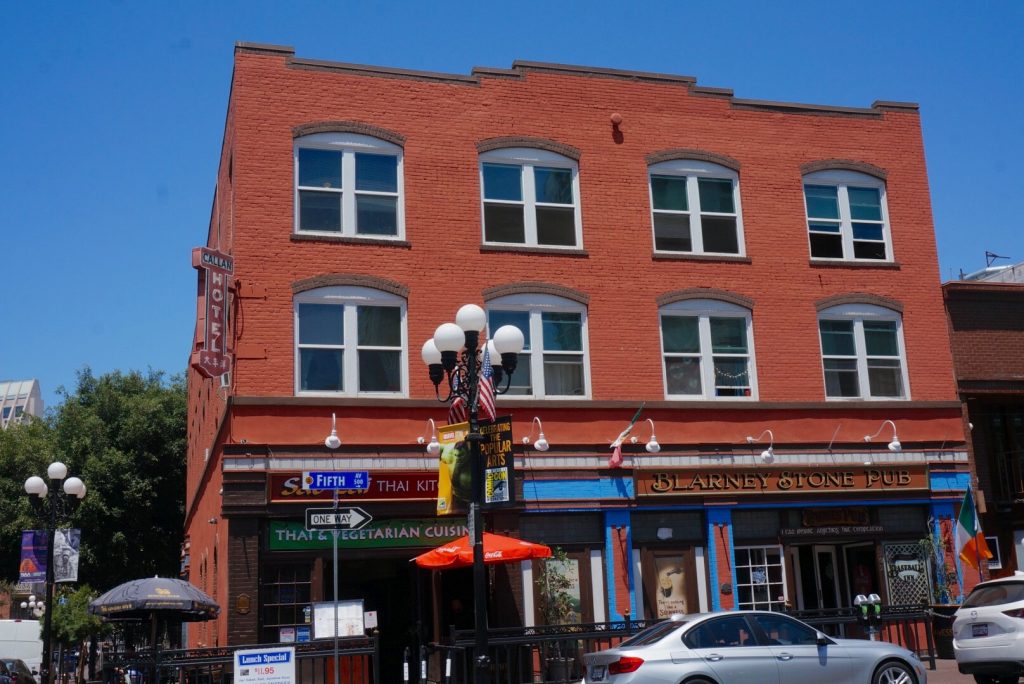Landmarks
The Callan Hotel
San Diego’s First “Zoo”
1878
Three Story Brick Structure
502 Fifth Avenue
Architects: Stannard & Layman (1913): Additional Two Stories
As the days get warmer and summer approaches many San Diegans begin to seek outdoor entertainment. There are the beaches, Old Town, water parks, and of course, the world-famous San Diego Zoo. The first “zookeeper” in San Diego, however, was a colorful businessman and barkeep in the downtown Gaslamp District. His name was Tillman Burns, or Till for short. Till first owned the Phoenix, a drinking establishment on 5th and K, but then decided to move further uptown to 5th and Island, where he set about opening the Acme, a most elegant saloon and billiards parlor.
The first building on this property was a wooden structure owned by William Llewelyn, who purchased the property from Alonzo Horton in 1869. He added a pump and well the following year for fire prevention. The well was of little help, as the building burned down in 1877. Mr. Llewelyn then constructed a brick building on the site. This sturdy, but not architecturally significant edifice, had two storefronts, the larger one on the corner facing 5th Avenue. It was to this site that Till Burns and his menagerie arrived.
Till’s menagerie, which he began assembling at the Phoenix, consisted of tropical birds of every sort, numerous primates, an iguana, tarantula spiders, a porcupine and a rather ill-tempered bear named Bruin, which he chained outside. It was Till’s belief that these exotic creatures would tempt customers to come into his saloon. His saloon was described in the City Directory as containing reading rooms, an elegant bar, reception rooms, a billiard parlor and magnificent oil paintings. Additionally, there was a cabinet of curiosities from all over the world and newspapers from all the large Eastern cities. For those who were desirous of feminine company, colorfully dressed ladies drifted in and out of the back rooms, while the finest liquors were served freely at the bar. Unfortunately, Till was often cited in the newspapers for serving liquor without a license and keeping his bar open after midnight.
Things became really difficult for Till when his bear purportedly bit off most of Constable Wilbur’s nose. The lawman, whom many said was quite handsome, ran down the street to the doctor, who told him that anyone who was foolish enough to stick his face up to a bear deserved to get bitten. With that, the doctor turned him away, as there was nothing he felt he could do. The local populace now demanded that Mr. Burns get rid of his zoo, so Till turned them loose at the edge of town.
Till Burns ran the Acme until his death in 1904, at which time his son, also named Till, took over. Till Jr. ran the saloon until 1909. The property continued to be run as a saloon until 1914 by Louis Strada and A. Costanzi, who purchased the building from William Llewelyn, and added the upper two stories. Strada and Costanzi also ran the adjoining storefront as a saloon and a speakeasy during Prohibition until 1926 .
As the Asian community was becoming more commercially active, the Nippon Company gained control of the larger storefront in 1914, and ultimately purchased the property in 1926. The Nippon Company, an import business, used the storefront as their sales outlet and headquarters. The upstairs was run as the Hotel Pacific. It provided furnished rooms and office space for a variety of businesses – all Japanese. The Japanese Association of San Diego County, additionally, had their offices at the Pacific.
In 1941, under the direction of President Franklin Roosevelt’s Executive Order 9066, all Japanese were sent to internment camps and the property was seized by the bank. The San Diego Federal Savings and Loan Company became owner and reopened the hotel in 1943 under the name of Hotel Callan, which it retains to this day.
During the early part of the Gaslamp restoration, a colorful and historically themed mural adorned the Island Avenue side of the building. Created by Heidi Hardin, the mural featured an idyllic scene of El Monte Park in Lakeside at the turn of the last century. The nine-foot tall figures, each representing a Gaslamp pioneer, appear as if they are getting their picture taken. Among the characters are Tom Hom, Wayne Donaldson, Dan Pearson, Kit Goldman, Mario Torero, also an accomplished artist, Larry Nichols, Ben Parish and the artist herself! Ms. Hardin’s mural was the largest of the five commissioned by the Gaslamp Mural Project, who selected five artists from 71 applicants to adorn five sites in the Gaslamp. In completing her work, she recruited some of the local residents of the 5th Avenue Rescue Mission. A local Carl’s Junior donated 80 hamburgers, Hardin bought the French fries and anyone who wanted to paint was put to work. Now, an accomplished artist with her own gallery in San Francisco, Ms. Hardin credits her start as an artist to the mural project. Her latest endeavor is The Human Family/A Walk Through Paradise, which incorporates seven rooms and an elaborate stained glass dome as a focal point.
The Callan is currently a low-income single-room occupancy residence on the upper two stories, and a restaurant, Sab Lai Thai, on the street level. The Blarney Stone, a tavern, occupies the smaller adjoining storefront.
Learn more about the history of the Gaslamp by taking a historical walking tour with the Gaslamp Quarter Historical Foundation every Thursday at 1pm and Saturday at 11am.
Sandee Wilhoit is the historian and lead tour guide for the Gaslamp Quarter Historical Foundation. She can be reached at [email protected]
Gaslamp Landmarks is published monthly in the Downtown News, pick up your copy the first Friday of the month to be the first to read the article!

